Human Spaceflights
![]()
International Flight No. 110STS-61BAtlantis (2)23rd Space Shuttle missionUSA |
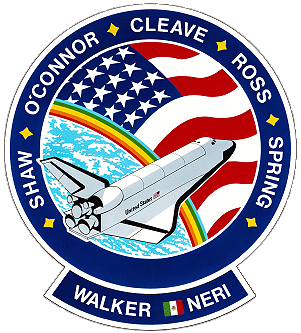 |
 |
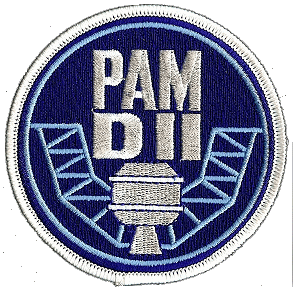 |
 |
|
![]()
Launch, orbit and landing data
walkout photo |
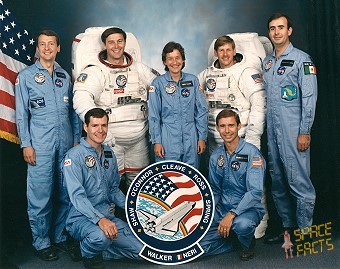 |
||||||||||||||||||||||||||||
alternative crew photo |
Crew
| No. | Surname | Given names | Position | Flight No. | Duration | Orbits | |
| 1 | Shaw | Brewster Hopkinson, Jr. | CDR | 2 | 6d 21h 04m 49s | 109 | |
| 2 | O'Connor | Bryan Daniel "O.C." | PLT | 1 | 6d 21h 04m 49s | 109 | |
| 3 | Ross | Jerry Lynn | MS-1, EV-1 | 1 | 6d 21h 04m 49s | 109 | |
| 4 | Cleave | Mary Louise | MS-2, RMS, FE | 1 | 6d 21h 04m 49s | 109 | |
| 5 | Spring | Sherwood Clark "Woody" | MS-2, EV-2 | 1 | 6d 21h 04m 49s | 109 | |
| 6 | Walker | Charles David | PS-1 | 3 | 6d 21h 04m 49s | 109 | |
| 7 | Neri Vela | Rodolfo | PS-2 | 1 | 6d 21h 04m 49s | 109 |
Crew seating arrangement
|
 |
|
||||||||||||||||||||||||||||||||
Backup Crew
|
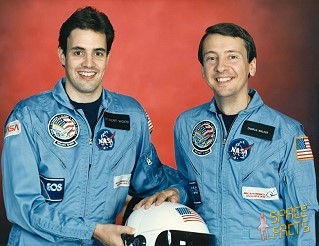
|
|||||||||||||||
 |
||||||||||||||||
Hardware
| Orbiter : | OV-104 (2.) |
| SSME (1 / 2 / 3): | 2011 (3.) / 2019 (3.) / 2017 (5.) |
| SRB: | BI-023 |
| ET: | ET-22 (LWT-15) |
| OMS Pod: | Left Pod 03 (7.) / Right Pod 01 (8.) |
| FWD RCS Pod: | FRC 4 (2.) |
| RMS: | 303 (1.) |
| EMU: | EMU No. 1077 (PLSS No. 1006) / EMU No. 1070 (PLSS No. 1011) / EMU No. 1079 (PLSS No. 1008) |
Flight
|
Launch from Cape Canaveral (KSC) and
landing on the Edwards
AFB, Runway
22. Main objectives of the mission were to deploy three communications satellites including RCA Satcom K-2 with the new D-2 model of the Payload Assist Module (PAM D-2). Also, aboard Atlantis for the STS-61B mission was EASE/ACCESS, a combination of the two experiments designed to study an extravehicular method of construction in space. The crew deployed the communications satellites Morelos B (Mexico), Aussat-2 (Australia) and RCA Satcom K-2 (USA) into Earth orbit. Morelos was the second of two spacecraft to be launched by the Space Shuttle for the Secretariat of Communications and Transportation, Mexico. The first Morelos spacecraft was deployed from the orbiter Discovery (STS-51G) in June 1985. Morelos was a spin-stabilized, gyrostat design with a despun antenna and communications payload. Two cylindrical solar panels, one fixed and one extendible, supply prime power to the spacecraft. At launch, Morelos was mated to the PAM-D stage with the antenna reflector and aft solar panel are stowed. The PAM-D stage supplies the necessary impulse for injection into a transfer orbit. Shortly after separation of the spacecraft from the orbiter Discovery, an omnidirectional antenna was deployed. Morelos' two cylindrical solar panels telescope opened when the spacecraft was in orbit. In launch position, with antenna reflector folded down, Morelos was 9 ft., 4 in. (2.86 meters) high. In orbit with panels extended and antenna erected, it was 21 ft., 8 in., (6.64 meters) high. It was 7 ft., 1 in. (2.16 meters) in diameter and weighed 1,422 lb. (645 kg) at the beginning of life in orbit. Four thrusters using 293 lb. (132 kg) of hydrazine propellant, provided orbit and attitude control during the satellite's 9-year planned mission life. From low-Earth orbit, the cradle's protective sunshield was opened and a table at the base spinned the satellite to 55 rpm to provide gyroscopic stability. Four springs pushed the satellite into space by command of Sherwood Spring and 45 minutes later, an onboard sequencer fired the McDonnell Douglas payload assist module (PAM). A Morton Thiokol Star apogee kick-motor places the satellite into a circular synchronous orbit. Aussat, the Australian national satellite communications system, provided a wide range of domestic services to the entire continent and its offshore islands. This included direct television broadcast to homesteads and remote communities, high-quality television relays between major cities, digital data transmission for both telecommunications and business use, voice applications for urban and remote areas, centralized air traffic control services and maritime radio coverage. Aussat-2 was the second in a system of three to be operated by Australia's national satellite company, Aussat Proprietary Ltd. Aussat-2 used two telescoping cylindrical solar panels and a folding antenna for compactness during launch. After the satellite neared its orbital position, the antenna erects and the outer solar panel deploys, exposing the inner solar array. Aussat's antenna system provided seven transmit beams and three receive beams. Five transmit beams served the Homestead and Community Broadcasting Satellite Service: four contiguously placed over the western, central, northeast and southeast regions of the Australian content and one over Papua, New Guinea. The other two are national beams which provide continental coverage for Fixed Satellite Service. Aussat carried 15 channels, each 45 MHz wide. Four used high-power, 30-watt traveling wave tube amplifiers (TWTAs) to provide radio and television services to Australia's remote areas. The remaining 11 channels operated with 12-watt TWTAs. It was possible to connect the communications channels individually to the transmit beams by ground command. This arrangement will provide traffic flexibility for the system. The satellite's diameter was nearly 7.2 ft. (2.19 meters). Stowed for launch its height was 9.2 ft. (2.80 meters). In orbit, with antennas deployed and aft solar panel extended, the height increased to 71 ft. (21.64 meters). Its initial on-station weight was about 1,322 lb. (599 kg). The deployment of this satellite also was primarily the task of Sherwood Spring. A PAM-D upper stage boosted the spacecraft to geosynchronous orbit. Two of a planned fleet of three communications satellites, operating in the Ku-band part of the spectrum, was launched for RCA American Communications, Inc., in 1985. Each of the spacecraft, designated Satcom K-1, K-2 and K-3, had 16 channels operating at 54 MHz usable bandwidth while providing coverage of the continental 48 states. The spacecraft were designed to provide coverage to the continental 48 states, or to either the eastern half or western half. The first of the series to be launched was Satcom K-2, on STS-61B, which was assigned an orbital position of 81 degrees west longitude. The three-axis stabilized spacecraft were equipped with power, attitude control, thermal control, propulsion, structure, and command ranging and telemetry systems necessary to support mission operations from launch vehicle separation through 10 years of operational life in geosynchronous orbit. This new generation of spacecraft carried 45-watt transponders, which permits the use of Earth station antennas a small as 3 ft. (0.91 meter) in diameter. Because Ku-band frequencies are not shared with terrestrial microwave systems, antennas served by the satellites could located within major metropolitan areas characterized by heavy terrestrial microwave traffic. The Satcom KU-band communications capability was provided by 15 45-watt traveling wave tube amplifiers for each of the 16 channels and six traveling wave tube amplifiers for redundancy. The 16 channels were set up in two groups of eight, each group contains three spare amplifier tubes. Each of the 16 channels used active frequency and polarization interleaving to permit the simultaneous use of each. The channels had a usable bandwidth of 54 MHz. The 4,144-pound (1,879 kg) RCA Satcom K-2 communications satellite was ejected from the payload bay on Flight Day 3 under the direction of mission specialist Jerry Ross. This was the first deployment of a spacecraft on the uprated D-2 model of the Payload Assist Module (PAM D-2). The PAM D-2 was instrumented with radio frequency telemetry which will downlink data to tracking aircraft during the burn of the solid rocket motor, a mission requirement for the first flight of a PAM-D2. This uprated, upper stage was identical to the PAM-D, except for size and weight. The spin-up was noticeably slower due to the larger mass and inertial components of the payload. PAM-D2 was designed to lift up to 4,200 lb. (1,905 kg) to geosynchronous orbit, compared to the 2,800-lb. (1,270 kg) PAM-D version. A key element of the mission's objectives was EASE/ACCESS, an experiment in assembling large structures in space. The goal of the EASE/ACCESS experiments was to construct the first large structures in space. In both experiments, crew members assembled small components to form larger structures, just as may eventually be done to build the Space Station. EASE/ACCESS was a joint venture between the Langley Research Center and the Marshall Space Flight Center. ACCESS was a "high-rise" tower composed of many small struts and nodes. EASE was a geometric structure shaped like an inverted pyramid, composed of a few large beams and nodes. Together, they demonstrated the feasibility of assembling large pre-formed structures in space. The entire structure of ACCESS consisted of 93 tubular aluminum struts 1 inch (2.5 centimeter) in diameter. Thirty-three were 4.5-ft.-long (1.37 meter) struts; 60 are 6-ft.-long (1.83 meter) diagonal struts; 33 were identical nodal joints (1 bay or cell); 9 struts were used within and between bays; 6 struts join at one node. The EASE structure consisted of 6 aluminum beams, each 12 ft. (3.66 meters) long, weighing 64 lb. (29 kg), containing four identical nodal joints. Two EVAs were performed by Jerry Ross and Sherwood Spring on November 29, 1985 (5h 32m) and December 01, 1985 (6h 41m). It was a major demonstration of construction techniques to build structures in orbit, which was successfully accomplished. This construction techniques will be used in the future for EVA's from the International Space Station. This activities were recorded by an IMAX large movie camera mounted in the cargo bay, obtaining some excellent coverage. The first EVA by Jerry Ross and Sherwood Spring began with the ACCESS experiment. The baseline experiment assembly technique required both crew members to be positioned in designated work areas: one stood in foot restraints at the support structure base and the other worked in similar restraints on top of the work platform. This "assembly line in space" technique allowed rapid construction for measurements of productivity. ACCESS assembly procedures were unstow assembly fixture, raise it to a vertical position, and unfold three guiderails; remove struts and nodes from three stowage canisters; connect nodes and struts on assembly fixture, forming one cell or bay; slide finished bay upward along guiderails to the top of the assembly fixture; repeat procedure to construct nine more bays; and disassembled by sliding bays down, removing and stowing nodes and struts. The second half of this EVA was devoted to the EASE experiments. To measure learning and productivity, the structure was assembled and disassembled repeatedly. The baseline experiment techniques allowed astronauts to move about freely, using foot restraints as necessary. EASE assembly procedures were unstow beams clamped to the front of the work platform; connect three vertical beams to a node attached to the top of the work platform; connect three horizontal beams to the three vertical beams by nodes; and repeatedly assembled and disassembled structure. The second EVA began with the construction of nine ACCESS bays using the baseline experiment technique. One crew member then was positioned on the manipulator foot-restraint work station and moved around by Mary Cleave from inside the flight deck. The manipulator work station was outfitted with a specially designed ACCESS component carrier. The second ACCESS assembly procedures were assembled first nine bays from fixed work stations mounted to the support structure; pack component carrier with struts and nodes needed to construct one bay; and move MFR crew member on the RMS to the top of the existing ACCESS bay where he completes the tenth bay. When 10 full bays were constructed, Space Station maintenance and repair tasks to be practiced were to stimulate stringing electrical cable, both crew members will string flexible cable along the ACCESS truss framework; to rehearse repair of a damaged structure, MFR crew member removes and replaces struts and nodes; and to practice handling large frameworks, MFR crew member removes entire structure from the assembly fixture and maneuvers it in the payload bay. At the end the structure was reattached, disassembled, and stowed. During the second half of the EVA, EASE was constructed with one crew member positioned in the foot restraint. The other worked at the equipment support structure base, using foot restraints as necessary. The second EASE assembly procedures were unstow beams clamped to front of work platform; move MFR crew member, equipped with beams and nodes, to the top of the EASE structure; attach three vertical beams to a node mounted on top of the support structure; and connect three horizontal beams to three vertical beams with nodes to complete structure. Rodolfo Neri Vela, the first payload specialist from Mexico, performed a series of mid-deck cabin experiments as well as took photographs of Mexico. The experiments were: Effects of Spatial Environment on the Reproduction and Growing of Bacteria (REPGROW) - Cultures of Escherichia coli B-strain bacteria will be mixed on orbit with different bacteriophages that attack the Escherichia coli and subsequently, were observed for possible changes and photographed as required. Transportation of Nutrients in a Weightless Environment (TRANSPORT) - Ten plant specimens were planted in containers that allowed a radioactive tracer to be released on orbit for absorption by the plants. At selected intervals, each plant was sectioned and the segments were retained for post-flight analysis to determine the rate and extent of absorption. Electropuncture and Biocybernetics in Space (ELECTRO-PUNCTURE) - The objective of the experiment was to validate electropuncture theories. These theories state that disequilibrium in the behavior of human organs can be monitored and stimulated by using electric dc current in specified zones. This experiment was performed by measuring the conductance of electricity in a predetermined zone. If a disequilibrium is detected, exercises or stimulus will be applied for a certain period until the value of the conductance falls into the normal range. Effects of Weightlessness and Light on Seed Germination (SEEDS) - Seed specimens of amaranth, lentil and wheat were planted on orbit during Flight Day 2 in two identical containers. Subsequently, one container was exposed to illumination and the other to constant darkness. Photographs of the resulting sprouts were taken every 24 hours. One day prior to landing, the sprouts were submitted to a metabolical detention process for subsequent histological examination on Earth to determine the presence and localization of starch granules. Photography of Mexico (PHOTO) - Post-earthquake photography of Mexico and Mexico City. The Diffusive Mixing of Organic Solutions (DMOS-2) experiment was intended to grow organic crystals in near-zero gravity. 3M scientists hoped to produce single crystals that are purer and larger than those available on Earth and studied their optical and electrical properties. DMOS experiments also included an investigation into the process of fluid mixing within the DMOS cells. One of the potential applications, of the crystals 3M is growing, was making optical devices comparable to electronic devices, though much faster. Possible uses include optical switches and computers that process information with light instead of electricity. The hardware for DMOS-2 was similar in size and function to that of DMOS-1. However, the new hardware was of modular construction and includes a quick-change cell installation feature, larger loading holes for chemicals, a more positive valve-opening assembly that uses a lever instead of the cam-and-roller of DMOS-1 and electronics mounted on each cell instead of on a single control board. Of the four crystal growth experiments, two were devoted to studies of the molecular growth and ordering under near ideal conditions in space and the other two examined the way crystals pack together and how this packing affects their electro-optical properties. One of the crystal growing experiments used cyanine tosylate and triethylammonium oxonol in chloroform. The other crystal growth and both crystal packing experiments used proprietary chemicals. The McDonnell Douglas continuous flow electrophoresis device made its seventh trip into space aboard Atlantis on flight STS-61B. The objective of this mission was to separate a sufficient quantity of biological material for animal and clinical testing of a breakthrough pharmaceutical. Charles Walker, McDonnell Douglas engineer and payload specialist, monitored the operation of this machine and conduct biological assays. This was Charles Walker's third flight as payload specialist. The continuous flow electrophoresis device operated for about 175 hours during the mission. To ensure that the desired hormone was being separated and collected within the fluid modules, once each day Charles Walker ran a test on a sample of material taken from the collection streams. Using assay material carried on board separately, he tested for hormone presence in the fluid. Charles Walker tested daily for the presence of contamination. These tests were made by withdrawing small samples of fluid from five locations and incubating them in vials previously loaded with freeze-dried reactants. Post-flight results from mission STS-51D in April 1985 showed that preflight levels of cleanliness were maintained. The hand-held Protein Crystal Growth Experiment, conducted by payload specialist Charles Walker, it was one of a series of experiments being flown to study the possibility of crystallizing biological materials such as hormones, enzymes and other proteins. Successful crystallization of these materials, which are very difficult to crystallize on Earth, will allow their three-dimensional atomic structure to be determined by Xray crystallography. Knowledge of the atomic structure hopefully will lead to a capability to develop pharmaceuticals to enhance or inhibit the protein's function on a rational manner. The experiment consisted of two vapor diffusion crystal growth units and one dialysis growth unit. Each vapor diffusion unit was 3 in. (7 centimeters) wide, 14 in. (35 centimeters) long and 1/2 in. (1.2 centimeter) thick and contained 24 small crystal growth chambers. Each of the 48 chambers were equipped with a porous liner saturated with precipitating agent such as alcohol or saline solution. A small drop of protein solution was injected into each chamber shortly after entering orbit. The IMAX project is a cooperative effort between the Canadian IMAX company and NASA. The system uses a specially designed 70 mm film camera to record color motion images on specially sprocketed film. During this flight, the IMAX camera was used to document payload bay activities associated with the EASE/ACCESS assembly during the two planned space construction walks. The camera was mounted in the payload bay in a pressure-sealed container with viewing windows. The windows had a sliding door which opened when the camera was in operation. The camera was controlled from the aft flight deck, exposing the film through a 30 mm fisheye lens. IMAX cameras flew on missions STS-41C, STS-41D and STS-41G to document payload bay and orbiter middeck and flight-deck crew activities along with spectacular views of space and the Earth. Film from those missions was included in the IMAX production "The Dream is Alive". The mission was shortened for one orbit, because of bad weather forecast in the landing area. |
EVA data
| Name | Start | End | Duration | Mission | Airlock | Suit | |
| EVA | Ross, Jerry | 29.11.1985, 21:45 UTC | 30.11.1985, 03:17 UTC | 5h 32m | STS-61B | Atlantis | EMU No. 1077 |
| EVA | Spring, Sherwood | 29.11.1985, 21:45 UTC | 30.11.1985, 03:17 UTC | 5h 32m | STS-61B | Atlantis | EMU No. 1070 |
| EVA | Spring, Sherwood | 01.12.1985, 20:3? UTC | 02.12.1985, 03:1? UTC | 6h 41m | STS-61B | Atlantis | EMU No. 1070 |
| EVA | Ross, Jerry | 01.12.1985, 20:3? UTC | 02.12.1985, 03:1? UTC | 6h 41m | STS-61B | Atlantis | EMU No. 1077 |
Photos / Graphics
 |
 |
 |
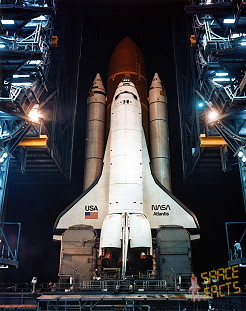 |
 |
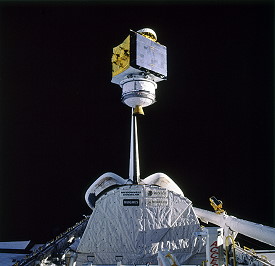 |
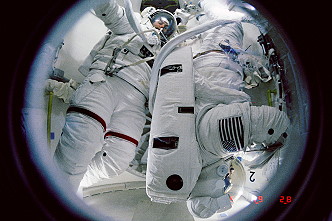 |
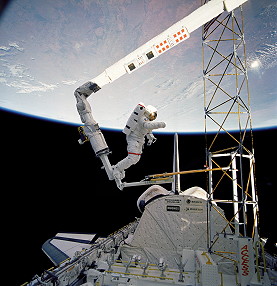 |
 |
 |
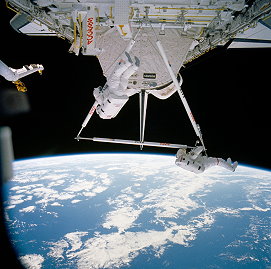 |
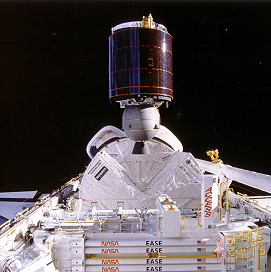 |
 |
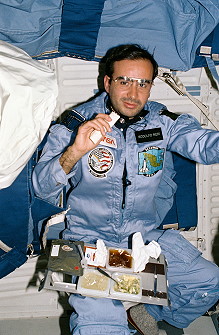 |
 |
 |
 |
 |
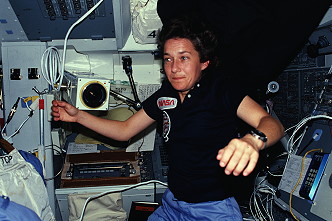 |
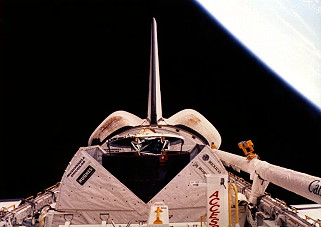 |
 |
|
more EVA photos |
|
| © |  |
Last update on December 02, 2023.  |
 |